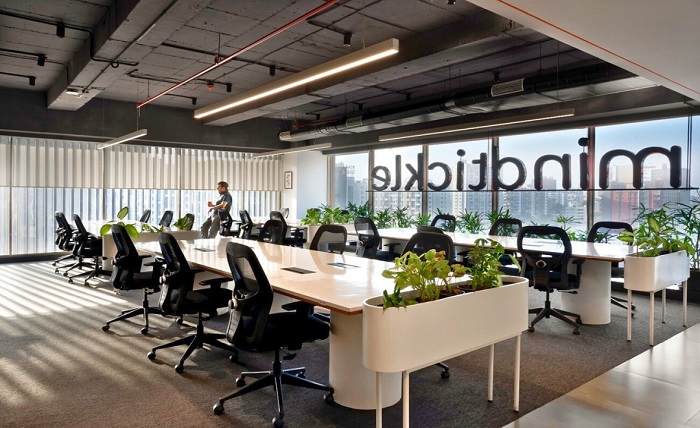The modern office is evolving, driven by the need for flexibility and efficiency. In an era where remote work and in-person collaboration coexist, designing an adaptable workspace is crucial. This blog post will explore practical tips for creating a flexible office layout that caters to diverse needs. Whether you’re an entrepreneur setting up a new space or a manager looking to optimize an existing one, you’ll find valuable insights here.
Understanding the Need for a Flexible Workspace
A flexible workspace is not just a trend; it’s a necessity in today’s dynamic business environment. Companies are increasingly adopting hybrid work models, where employees split their time between home and office. This shift demands spaces that can easily adapt to various tasks and team configurations.
Flexibility in an office setting means accommodating diverse working styles while fostering collaboration. It requires a balance of open areas for teamwork and private zones for focused work. By understanding the importance of flexibility, businesses can create environments that boost productivity and employee satisfaction.
Incorporating flexibility isn’t just about moving furniture around; it’s about strategically designing a space that evolves with changing needs. An adaptable layout ensures that your office remains functional and efficient, even as your team grows or changes.
The Role of Furniture in Adaptability
Furniture plays a pivotal role in creating a flexible workspace. Modular furniture pieces, such as desks and seating that can be rearranged easily, are essential. These allow for quick reconfiguration of the office layout, based on immediate needs.
Investing in multifunctional furniture can significantly enhance adaptability. For instance, adjustable-height desks cater to both sitting and standing preferences, promoting health and comfort. Similarly, mobile partitions can create temporary meeting rooms or private workspaces as required.
Selecting the right furniture involves considering durability and aesthetics alongside functionality. High-quality, versatile pieces can transform a static office into a dynamic environment that adapts to evolving work demands.
Incorporating Technology for Flexibility
Technology is a vital component of a flexible workspace. With the rise of digital workflows, having the right tech infrastructure is crucial. This includes reliable internet connectivity, wireless charging stations, and collaborative software tools.
Digital screens and projectors can turn any area into a presentation space, making it easier to hold impromptu meetings. Smartboards facilitate interactive brainstorming sessions, promoting team engagement and creativity.
Integrating technology seamlessly into the office layout enhances communication and collaboration. It allows employees to work efficiently from any location within the workspace, supporting both remote and in-office staff.
Zoning for Different Activities
Effective zoning is key to a flexible workspace. By dividing the office into distinct areas for different activities, businesses can cater to various work modes. This approach helps create a balanced environment that supports both individual focus and team collaboration.
Designate quiet zones for deep work, ensuring they are free from distractions and noise. Collaborative zones should be equipped with whiteboards, comfortable seating, and ample space for group discussions. Relaxation areas, complete with comfortable furnishings and greenery, provide employees with a place to recharge.
Thoughtful zoning encourages a smooth workflow and enhances productivity by providing the right setting for each task. This adaptability results in a workspace that meets the diverse needs of its occupants.
Maximizing Natural Light and Ventilation
Natural light and fresh air are essential elements in a flexible workspace. They contribute to a healthier, more pleasant environment that enhances employee well-being and productivity. When designing an office layout, consider how to maximize these natural resources.
Position workstations near windows to allow for ample daylight, reducing the need for artificial lighting. Incorporating plants and natural elements can improve air quality and create a calming atmosphere. Open windows or install ventilation systems to ensure a continuous flow of fresh air.
By prioritizing natural light and ventilation, companies can create a more inviting and adaptable workspace. This simple yet effective approach fosters a positive atmosphere and boosts productivity.
Adapting to Changing Needs
A key aspect of flexibility is the ability to adapt to changing needs. Businesses must anticipate future growth or shifts in work patterns. Regularly assessing and adjusting the office layout is essential to maintaining efficiency and comfort.
Conduct surveys or hold feedback sessions to understand employees’ evolving requirements. This input can guide decisions on space utilization, furniture arrangement, and technology integration. By actively engaging with employees, companies can create a responsive workspace that supports their teams effectively.
Flexibility is not a one-time project; it’s an ongoing process. By remaining proactive, businesses can ensure their office layout continues to meet the demands of a dynamic work environment.
Creating a Welcoming and Inclusive Environment
Flexibility also involves creating an inclusive environment that caters to all employees. Consider accessibility features, such as ramps, wide doorways, and adjustable desks, to accommodate diverse needs. Inclusivity fosters a sense of belonging and boosts morale.
Design elements, such as color schemes and artwork, can influence mood and energy levels. Choose elements that reflect the company’s culture and values, creating a cohesive and inviting atmosphere. Including breakout areas for social interaction can further enhance team cohesion.
By fostering an inclusive environment, businesses can create a flexible workspace that encourages collaboration and innovation. This approach not only benefits employees but also contributes to a positive corporate image.
Balancing Open and Private Spaces
Striking the right balance between open and private spaces is crucial for flexibility. Open layouts promote collaboration and communication, while private areas support focused work and confidentiality.
Consider using flexible partitions or movable walls to create temporary private spaces as needed. Soundproofing materials can help manage noise levels, ensuring a comfortable environment for all employees. By offering a variety of work settings, businesses can cater to different preferences and tasks.
Balancing open and private spaces requires thoughtful planning and design. This balance enhances the overall functionality of the workspace, making it adaptable to a range of activities.
The Impact of Color and Design
Color and design play a significant role in creating a flexible workspace. The choice of colors can influence mood, productivity, and creativity. Bright, energetic colors may inspire creativity, while softer tones promote calm and focus.
Incorporate elements that reflect the company’s brand identity, creating a cohesive visual experience. Consider versatile design features, such as moveable art installations or customizable decor, that allow for easy updates and personalization.
By paying attention to color and design, businesses can create a dynamic and adaptable workspace that inspires employees and reflects their corporate culture.
The Role of Storage Solutions in Flexibility
Effective storage solutions are integral to maintaining a clutter-free and flexible workspace. Choose modular storage units that can be reconfigured or expanded as needed. This adaptability ensures that storage remains functional and efficient as the office evolves.
Incorporate both open and closed storage options to accommodate different needs. Open shelves allow for easy access to frequently used items, while closed cabinets help maintain a tidy appearance. Consider multi-functional furniture, such as desks with built-in storage, to maximize space.
By investing in versatile storage solutions, businesses can keep their workspace organized and adaptable, contributing to a more efficient and productive environment.
The Importance of Collaboration Areas
Collaboration areas are essential components of a flexible workspace. These zones encourage team interaction, creativity, and problem-solving. When designing collaboration spaces, prioritize comfort and versatility.
Incorporate flexible seating arrangements, such as modular sofas or movable chairs, to accommodate different group sizes. Provide technology tools, like video conferencing equipment and interactive displays, to facilitate communication and collaboration. Ensure that these areas are well-lit and welcoming to inspire creativity.
By emphasizing collaboration areas, businesses can foster a culture of innovation and teamwork. These spaces become hubs of creativity, driving progress and success.
Conclusion
Designing a flexible workspace is a strategic move that can enhance productivity and employee satisfaction. By focusing on adaptability, businesses can create environments that cater to diverse needs and evolving work patterns. From furniture and technology to zoning and inclusivity, each element plays a vital role in achieving flexibility. By implementing these tips, companies can transform their office layouts into dynamic, efficient, and inviting spaces that support both individual and collective success.
For those looking to further customize their workspace, incorporating unique materials, such as a garage floor sealer in Salt Lake City, can add a distinctive touch. Whether you’re starting anew or revamping an existing space, the key is to remain agile and responsive to change.



